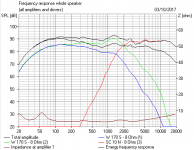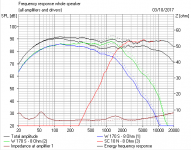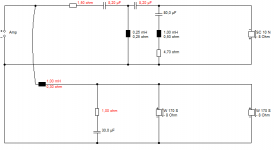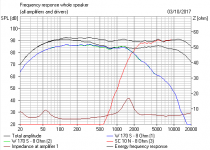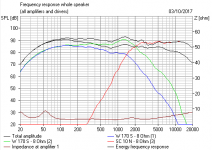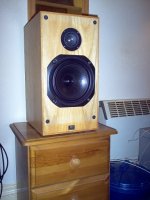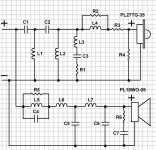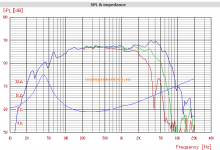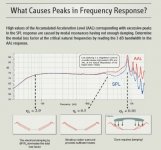Take a difficult woofer, which incidentally, Troels Gravesen doesn't think is strictly suitable for a 2.5kHz two way:
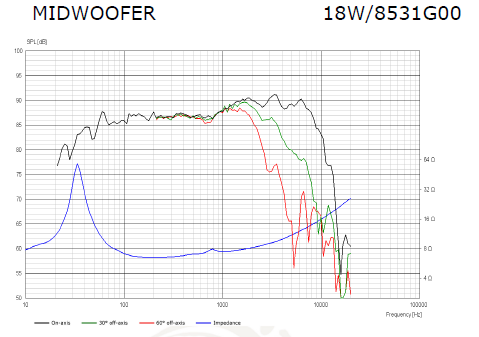
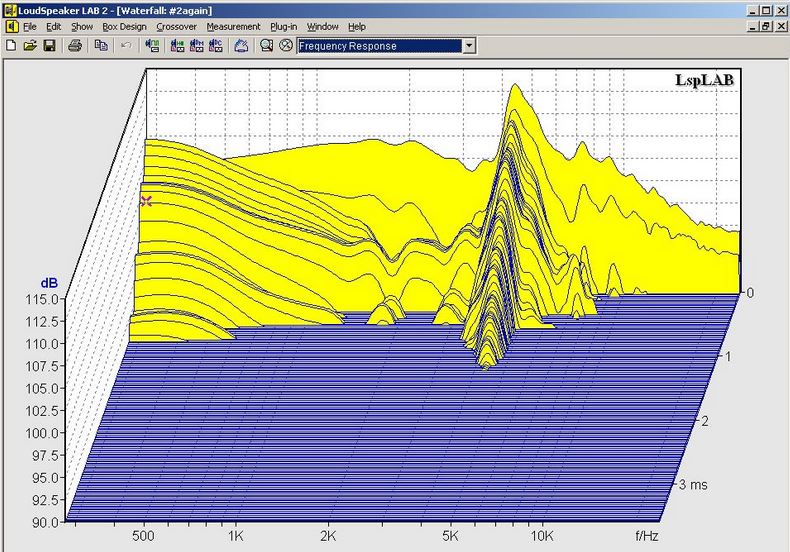
Give it a weird and low 1.7kHz crossover.
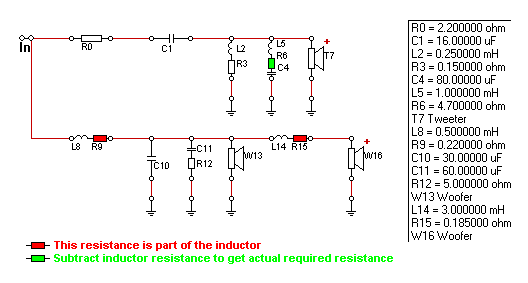
I just ran the sim with imported Zaph FRD and ZMA files for the woofer. It's not pretty. That lump at 1.2kHz is stubborn. And we know about the breakup at about 4.5kHz. Little bit better with a 0.7mH bass coil, IMO. It worked a bit better as a regular MTM too.
Give it a weird and low 1.7kHz crossover.
I just ran the sim with imported Zaph FRD and ZMA files for the woofer. It's not pretty. That lump at 1.2kHz is stubborn. And we know about the breakup at about 4.5kHz. Little bit better with a 0.7mH bass coil, IMO. It worked a bit better as a regular MTM too.
Attachments
Last edited:
Take a difficult woofer, which incidentally, Troels Gravesen doesn't think is strictly suitable for a 2.5kHz two way:
I just dug up his old SP95 design which has been hidden from his site for a while now and I see where he said that. I did catch him hinting at it not being suitable in a 2-way elsewhere a while ago too.
At this point it is a fair bit better. At least it no longer makes me want to shut off the sound on 90% of recordings like it used to. I really find that the 3.2khz cut makes a nice difference and makes the speaker less fatiguing. I only have the EQ cut but 4-5db too. When I cut at 1khz (which is as close to 1.2 as I can get), it doesn't seem to make much of an improvement. The bump here is not particularly offensive to me I guess.
I will maybe try to put a notch filter on the woofer in the crossover for the 3.2khz region, but only if my next build doesn't wind up re-using drivers from these speakers. I was considering Troels' 3-way using the dual 8531 woofers and the 4" revelator mid, but I don't know yet which direction I will go. So many designs I would like to try, as well as the possibility of designing my own possibly even going with an active XO system.
At 2 kHz, the 18W/4531 does fabulous in a 2-way. I listen to them every day and could not be happier.
Best,
E
Best,
E
Hi Merlinx76,
And good morning from the UK. Only just found this thread and had to chip in, threads like this are heart breaking and all too often I've seen them go the wrong way.
I should say first that we all love music, and we all love building amazing speakers, that's why we're here. As you well know, the kit you own should have the potential to sound astounding, it's disheartening to find it's not right, but it can be fixed.
Unfortunately the fix is going to take time and patience, and some skills - we can help with the last bit, but not the first two.
What I would say at first is stop throwing money at the problem, it isn't the way forward.
It's critical to understand some basic concepts about speaker design that many people (unfortunately even on this forum) will deny. Most importantly don't worry about air core vs cored inductors, don't worry about expensive capacitors, etc.
The single, most important thing to get a loudspeaker sounding right is the crossover. It's the brains of the operation, it does everything and is responsible for everything you hear. A well designed crossover with $0.20 components will **** all over a $5000 crossover if it's badly designed.
Secondly, why are loudspeakers so appealing for DIY? Well there's a few reasons, but the most relevant here is that loudspeakers represent the highest distortion in the signal path. Source->Amplified->Speakers.
Pound for pound, no matter the set up, the speakers will almost always contribute the greatest distortion.
This is key. Look at studio recording environments. They aren't ever going to be fatiguing unless that's what you've recorded.
The primary factors for studio speakers are flat, extended FR and low distortion (yes there are others but you can tend to focus on those as primary objectives)
Decades ago when I first worked in studios they were full of both expensive and cheap gear. You're quite right to use a flagship YAMAHA amp, it will serve you well as an amplifier and DAC. In fact, I do the same - I run a Denon AVC A11SR Home theatre amplifier using the external inputs as a 6 channel amplifier to tri-wire my monitors. That can be fed by a focusrite DAC, but it's currently getting the external DAC duties done from an $11 DAC box of amazon so I can run all my audio through my TV from the laptop. Music or video, it's going through a cheap DAC and a decent home theatre AMP.
Ok, a lot of information but I have a point - I can promise you my home set up could go toe to toe with and DIY or professional system. The loudspeakers themselves are nailed.
The lesson here is important:
- We need to focus on your loudspeakers, they are the source of the problem.
- for god's sake, please turn off any EQ when fixing and measuring, the goal is to have all EQ and post processing on your amp turned off, it WILL be detrimental to the final sound once we fix your speakers.
- We NEED to see measurements and pictures, I can't find any of these in the thread.
The problem you have is symptomatic of a high distortion peak somewhere, this could also be caused by a peak in response, which would also cause the distortions.
So here's a shopping & to do list for you:
- Buy a proper measurement microphone. Any wil do, as long as it includes measurement data you can import into ARTA. Likely be easiest to get a US powered version as XLR will need a seperate input box - if you go the XLR route and need an input to your PC try something like a Focusrite iTrack Solo. Cheap but accurate.
- Buy an LCR meter. Cheap high quality bare units can be found on ebay (search for 100 A inductance capacitance module, you'll likely need to get it from china)
Take photos of everything you have now and post them on the forum with clearly labelled wire.
The problem can be fixed, but without those two tools we're heading down a path of frustration.
I'll stay on this thread until you have a speaker that makes you happy. 🙂
And good morning from the UK. Only just found this thread and had to chip in, threads like this are heart breaking and all too often I've seen them go the wrong way.
I should say first that we all love music, and we all love building amazing speakers, that's why we're here. As you well know, the kit you own should have the potential to sound astounding, it's disheartening to find it's not right, but it can be fixed.
Unfortunately the fix is going to take time and patience, and some skills - we can help with the last bit, but not the first two.
What I would say at first is stop throwing money at the problem, it isn't the way forward.
It's critical to understand some basic concepts about speaker design that many people (unfortunately even on this forum) will deny. Most importantly don't worry about air core vs cored inductors, don't worry about expensive capacitors, etc.
The single, most important thing to get a loudspeaker sounding right is the crossover. It's the brains of the operation, it does everything and is responsible for everything you hear. A well designed crossover with $0.20 components will **** all over a $5000 crossover if it's badly designed.
Secondly, why are loudspeakers so appealing for DIY? Well there's a few reasons, but the most relevant here is that loudspeakers represent the highest distortion in the signal path. Source->Amplified->Speakers.
Pound for pound, no matter the set up, the speakers will almost always contribute the greatest distortion.
This is key. Look at studio recording environments. They aren't ever going to be fatiguing unless that's what you've recorded.
The primary factors for studio speakers are flat, extended FR and low distortion (yes there are others but you can tend to focus on those as primary objectives)
Decades ago when I first worked in studios they were full of both expensive and cheap gear. You're quite right to use a flagship YAMAHA amp, it will serve you well as an amplifier and DAC. In fact, I do the same - I run a Denon AVC A11SR Home theatre amplifier using the external inputs as a 6 channel amplifier to tri-wire my monitors. That can be fed by a focusrite DAC, but it's currently getting the external DAC duties done from an $11 DAC box of amazon so I can run all my audio through my TV from the laptop. Music or video, it's going through a cheap DAC and a decent home theatre AMP.
Ok, a lot of information but I have a point - I can promise you my home set up could go toe to toe with and DIY or professional system. The loudspeakers themselves are nailed.
The lesson here is important:
- We need to focus on your loudspeakers, they are the source of the problem.
- for god's sake, please turn off any EQ when fixing and measuring, the goal is to have all EQ and post processing on your amp turned off, it WILL be detrimental to the final sound once we fix your speakers.
- We NEED to see measurements and pictures, I can't find any of these in the thread.
The problem you have is symptomatic of a high distortion peak somewhere, this could also be caused by a peak in response, which would also cause the distortions.
So here's a shopping & to do list for you:
- Buy a proper measurement microphone. Any wil do, as long as it includes measurement data you can import into ARTA. Likely be easiest to get a US powered version as XLR will need a seperate input box - if you go the XLR route and need an input to your PC try something like a Focusrite iTrack Solo. Cheap but accurate.
- Buy an LCR meter. Cheap high quality bare units can be found on ebay (search for 100 A inductance capacitance module, you'll likely need to get it from china)
Take photos of everything you have now and post them on the forum with clearly labelled wire.
The problem can be fixed, but without those two tools we're heading down a path of frustration.
I'll stay on this thread until you have a speaker that makes you happy. 🙂
Well, I've made tremendous progress with this rank-bad Zaph 2.5 design! 😀
The problem really is that the bass is too difficult for a overly simple 2.5 way circuit.

The Zaph 2.0 two-way looks OK. Which is why eriksquires gets on with it with his 4531.
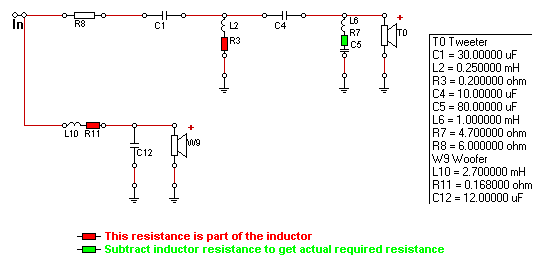
See the 18W/8531G00 (Sliced paper) bass gets some serious rolloff. Big old 2.7mH bass coil! And more of a third order filter.

I see no need for measuring equipment or microphones since we have the ZMA and FRD files for the woofer. Can't be bothered with the tweeter, since they are all much the same and dominated electrically by the filter.
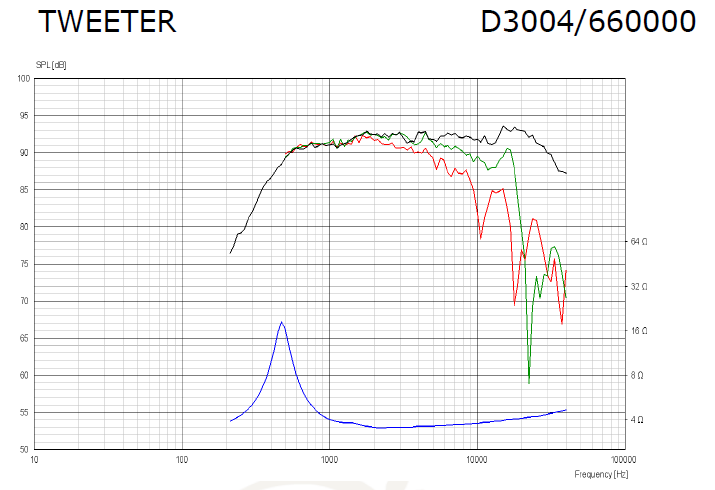
My TMM design is MUCH better than Zaph's IMNSHO, even if I don't like the woofers at all. Phase is better and more aligned. FR is smoother. Impedance could be improved, but not too shocking. I have speakers with impedance like this, and they work, and would be excellent bi-wired. The tweeter is not working so hard so will sound sweeter.
A few notes. I didn't work too hard at the tweeter so impedance is not strictly accurate. I did think Zaph should have used a smaller (2.7R) resistor in the LCR. But not a biggie. In fact a single 1mH coil would work almost exactly the same. I would keep the coils well apart and right-angled. That 1mH in the tweeter circuit could pick up a lot of bass-coil rubbish.
The problem really is that the bass is too difficult for a overly simple 2.5 way circuit.
The Zaph 2.0 two-way looks OK. Which is why eriksquires gets on with it with his 4531.
See the 18W/8531G00 (Sliced paper) bass gets some serious rolloff. Big old 2.7mH bass coil! And more of a third order filter.
I see no need for measuring equipment or microphones since we have the ZMA and FRD files for the woofer. Can't be bothered with the tweeter, since they are all much the same and dominated electrically by the filter.
My TMM design is MUCH better than Zaph's IMNSHO, even if I don't like the woofers at all. Phase is better and more aligned. FR is smoother. Impedance could be improved, but not too shocking. I have speakers with impedance like this, and they work, and would be excellent bi-wired. The tweeter is not working so hard so will sound sweeter.
A few notes. I didn't work too hard at the tweeter so impedance is not strictly accurate. I did think Zaph should have used a smaller (2.7R) resistor in the LCR. But not a biggie. In fact a single 1mH coil would work almost exactly the same. I would keep the coils well apart and right-angled. That 1mH in the tweeter circuit could pick up a lot of bass-coil rubbish.
Attachments
Last edited:
Steve,
The symptoms he is describing are symptomatic of a high distortion point or high fr peak.
Those both indicate to me that there's either faulty wiring, a faulty tweeter or out of spec component(s).
The OP's experience does not reflect those of other users, so let's rule out the obvious before we decide the fault is all.in zaphs design yes?
I don't disagree with your comments, but I don't agree with the diagnosis. Without accurate measurements we're slinging mud at a wall. I'm this case the wall is covered in oil.
The symptoms he is describing are symptomatic of a high distortion point or high fr peak.
Those both indicate to me that there's either faulty wiring, a faulty tweeter or out of spec component(s).
The OP's experience does not reflect those of other users, so let's rule out the obvious before we decide the fault is all.in zaphs design yes?
I don't disagree with your comments, but I don't agree with the diagnosis. Without accurate measurements we're slinging mud at a wall. I'm this case the wall is covered in oil.
Steve,
The symptoms he is describing are symptomatic of a high distortion point or high fr peak.
Those both indicate to me that there's either faulty wiring, a faulty tweeter or out of spec component(s).
The OP's experience does not reflect those of other users, so let's rule out the obvious before we decide the fault is all.in zaphs design yes?
I don't disagree with your comments, but I don't agree with the diagnosis. Without accurate measurements we're slinging mud at a wall. I'm this case the wall is covered in oil.
The crossovers have been tested by Madisound and check out OK. The speakers have also been hooked up at least 5-6 times so I did not do it wrong every time. Phase of everything has been checked and re-checked and checked again. Also tried wiring the tweeters in the opposite phase just to see. There could possibly be a bad driver but I can't find one speaker sounding better than the other. What are the chances that there are 2 bad drivers? Could these all be so far out of spec to not work with the crossover? Scan-Speak has pretty good quality control.
I'm not discarding either of your ideas really but these are both almost opposite views. I don't know yet which way I want to proceed. The recent changes have made a significant improvement so I have time to think about things now. Thank you for your time though. I will consider what both of you have said on the matter for sure.
I don't much care what other people think. I often listen to some of the best speakers in the World, but am always aware that all of them make compromises. 😀
I'm a person who builds speakers, and gives them a good long-term listen. And lots of designs do win a cigar. Even my cone tweetered speakers below which never get much love because they seem too cheap. 🙄
I have never really had much luck with 6" woofers. They force you to a low crossover, which is not good for tweeter distortion. They only have 12dB/octave rolloff on simple filters which exposes you to the 4.5kHz breakup and it's main second harmonic at 9kHz.
Sure it could be a rubbing voicecoil on the tweeter. Perhaps it is that some people, like myself, just detest the spitty and bright and broken-up sound of soft-domes. It's actually quite questionable if you want a mid or a tweeter with wide-dispersion.
After many years grappling with all the combinations, I think 5" basses with a 3.5kHz tweeter are quite easy. 8" bass can be good too because you can use negative polarity and BW3 to fix the time alignment and dispersion problems at 3.5kHz. Joachim Gerhard is currently having a serious go with SEAS U22 and SEAS DXT tweeter on simple crossover. The serious answer is really to build a 3 way, IMO.
6" bass is a heap of trouble in a two way. Best efforts I've seen are by our own Michael Chua:
Vifa PL18 Premium Line
Seas ER18RNX with 27TDFC
IMO, 6" 2.5 way is just the worst of all worlds. Nothing works too well.
I'm a person who builds speakers, and gives them a good long-term listen. And lots of designs do win a cigar. Even my cone tweetered speakers below which never get much love because they seem too cheap. 🙄
I have never really had much luck with 6" woofers. They force you to a low crossover, which is not good for tweeter distortion. They only have 12dB/octave rolloff on simple filters which exposes you to the 4.5kHz breakup and it's main second harmonic at 9kHz.
Sure it could be a rubbing voicecoil on the tweeter. Perhaps it is that some people, like myself, just detest the spitty and bright and broken-up sound of soft-domes. It's actually quite questionable if you want a mid or a tweeter with wide-dispersion.
After many years grappling with all the combinations, I think 5" basses with a 3.5kHz tweeter are quite easy. 8" bass can be good too because you can use negative polarity and BW3 to fix the time alignment and dispersion problems at 3.5kHz. Joachim Gerhard is currently having a serious go with SEAS U22 and SEAS DXT tweeter on simple crossover. The serious answer is really to build a 3 way, IMO.
6" bass is a heap of trouble in a two way. Best efforts I've seen are by our own Michael Chua:
Vifa PL18 Premium Line
Seas ER18RNX with 27TDFC
IMO, 6" 2.5 way is just the worst of all worlds. Nothing works too well.
Attachments
Merlinx76, Having read through this whole thread one thing not mentioned is ....are your drivers properly seated on the baffle ? Any air leaks or small gaps around the woofers is likely to introduce the problems you are having. Check that as a possible problem as it is an easy fix.
C.M
C.M
You are mixing with the big boys here. How can a miniscule airleak possibly interact with a leaky (in terms of baffle-airfow) reflex design?
Zaph|Audio - ZRT - Revelator Tower
You are clutching at straws, IMO. It's a rotten design. 🙂
Zaph|Audio - ZRT - Revelator Tower
You are clutching at straws, IMO. It's a rotten design. 🙂
Originally the problem was a large peak at 1 kHz. Now it seems to be a problem at 3.2kHz. Have you:
1. Tried a completely different amp and source. Even if the amp is a cheap one you can see if maybe your dac is the problem or maybe there's some hidden frequency adjustment in your AV amp.
2. Listened to the woofers individually with a frequency scan (I use one from you-tube). This is without the crossover. Then hook up each woofer individually to the crossover and listen to that. If there is a large peak you will hear it.
3. If the woofers are sounding good then add in the tweeter and see what happens. Run a sweep again on the entire speaker.
What I'm getting at is that even if you do not have test equipment you can accomplish much by just listening. Also, I find for myself that it helps to deal with one thing at a time when troubleshooting.
Could you post at least a couple of pictures of the speaker? So much discussion and nothing to look at!
1. Tried a completely different amp and source. Even if the amp is a cheap one you can see if maybe your dac is the problem or maybe there's some hidden frequency adjustment in your AV amp.
2. Listened to the woofers individually with a frequency scan (I use one from you-tube). This is without the crossover. Then hook up each woofer individually to the crossover and listen to that. If there is a large peak you will hear it.
3. If the woofers are sounding good then add in the tweeter and see what happens. Run a sweep again on the entire speaker.
What I'm getting at is that even if you do not have test equipment you can accomplish much by just listening. Also, I find for myself that it helps to deal with one thing at a time when troubleshooting.
Could you post at least a couple of pictures of the speaker? So much discussion and nothing to look at!
Originally the problem was a large peak at 1 kHz. Now it seems to be a problem at 3.2kHz. Have you:
1. Tried a completely different amp and source. Even if the amp is a cheap one you can see if maybe your dac is the problem or maybe there's some hidden frequency adjustment in your AV amp.
2. Listened to the woofers individually with a frequency scan (I use one from you-tube). This is without the crossover. Then hook up each woofer individually to the crossover and listen to that. If there is a large peak you will hear it.
3. If the woofers are sounding good then add in the tweeter and see what happens. Run a sweep again on the entire speaker.
What I'm getting at is that even if you do not have test equipment you can accomplish much by just listening. Also, I find for myself that it helps to deal with one thing at a time when troubleshooting.
Could you post at least a couple of pictures of the speaker? So much discussion and nothing to look at!
Most of these problems tend to be xover related. I suspect all Zaph speakers are on the bright side from looking at his measurements. I don't think one should purchase a different amp because of xover short comings.
Last edited:
i have tried a different amp and source. Cant really run woofers 1 at a time in the crossover because of the design. Did run each pair of woofers by themselves with and without the crossover. I have listened to sweeps, hard to spot what the problem is with any of these techniques.
As I said in a recent post, the best I have been able to achieve was with a 1/3 octave EQ going through each band to find where the biggest annoyance is. 3.2khz is definitely a problem and maybe the most annoying one. It is more tolerable now. Using the EQ, I have a hard time finding any other really annoying frequency unless the speaker is just bright over a wide frequency range as Andy2 said. I have the tweeter attenuated slightly with a .47 ohm resistor and it probably could use a bit more, but in the past I have found that attenuating the tweeter has not done much to help with the annoyance.
But without measurements, there isnt much we can do but speculate (and argue!) since none of you are able to listen to it and see if it is really that bad, just minor issue to you, or a characteristic of the design and I'm just being fussy.
As I said in a recent post, the best I have been able to achieve was with a 1/3 octave EQ going through each band to find where the biggest annoyance is. 3.2khz is definitely a problem and maybe the most annoying one. It is more tolerable now. Using the EQ, I have a hard time finding any other really annoying frequency unless the speaker is just bright over a wide frequency range as Andy2 said. I have the tweeter attenuated slightly with a .47 ohm resistor and it probably could use a bit more, but in the past I have found that attenuating the tweeter has not done much to help with the annoyance.
But without measurements, there isnt much we can do but speculate (and argue!) since none of you are able to listen to it and see if it is really that bad, just minor issue to you, or a characteristic of the design and I'm just being fussy.
And just to note one thing... They can sound very good at times with the right music... Piano by itself, for example, sounds incredible and better than any other speakers I have heard in my limited experience. It's not all bad.
You are mixing with the big boys here. How can a miniscule airleak possibly interact with a leaky (in terms of baffle-airfow) reflex design?
Zaph|Audio - ZRT - Revelator Tower
You are clutching at straws, IMO. It's a rotten design. 🙂
Excuse me, you certainly have some tabs on yourself. In all your posts in this thread you have not yet resolved the problem that he has, but rather you have bagged the original design as being mediocre and if anything, him as a bit of a fool for attempting such a design.
Bass reflex designs can develop quite high cabinet pressures and any small leaks can 'whistle' under such pressures. Try it yourself, pluck your lips and pant air through them, you'll find it produces a whisting sound even at the low pressures that you might develop between your cheeks.
C.M
I have EXACTLY defined the problem here. Sorry if that contradicts your sense of denial or cognitive dissonance. Look 'em up if you are interested. 🙂
http://www.diyaudio.com/forums/multi-way/311454-zaph-madisound-zrt-2-5-a-7.html#post5202862
Dear old Zaph, aka John Krutke, designed a pretty decent two-way. Unfortunately it goes HORRIBLY, HORRIBLY WRONG as a 2.5 way. Just the facts of it. 😀
I will happily mix it with John if he wants to claim his 2.5 way was anything less than a disaster. The science will win.
TBH, I have had my disasters too. But I just pick myself up. Dust myself off. And do better the next time.
http://www.diyaudio.com/forums/multi-way/311454-zaph-madisound-zrt-2-5-a-7.html#post5202862
Dear old Zaph, aka John Krutke, designed a pretty decent two-way. Unfortunately it goes HORRIBLY, HORRIBLY WRONG as a 2.5 way. Just the facts of it. 😀
I will happily mix it with John if he wants to claim his 2.5 way was anything less than a disaster. The science will win.
TBH, I have had my disasters too. But I just pick myself up. Dust myself off. And do better the next time.
I'm sorry but there is nothing wrong with the ZRT design. We can see from Zaph's system distortion measurements that the tweeter can handle the low xover point. In fact the overall distortion goes down as the tweeter takes over. The low xover point is definitely not the problem unless you are perhaps trying to listen at ridiculously loud levels.
The low xover point also has the benefit of keeping any woofer related crud off the radar too, but people have been using the same woofer in two ways and are extremely happy with the results. Heck doesn't Troels even use it as a dedicated midrange in some designs? And crossed at about 2.5k if memory serves.
Applying a cut at ~3kHz doesn't really tell you anything. This is the area where the ear is the most sensitive and all sorts of loudspeaker problems can be lessened by putting a notch filter in this region.
I haven't read the entire thread but from my experience a lack of bafflestep compensation (for your room) and/or tweeter levels being too high can easily cause these kind of tonal balance issues. In some designs just 1-2dB can make the difference between a listen all day type of sound and my god turn that off!
Tweeter level in this design is especially important because the xover frequency is so low. Having the tweeter running hot isn't just a case of 'too bright' it will make the speakers too forward and harsh/piercing. Do implement Zaph's reduced tweeter level options. Start with the lowest tweeter level and go from there.
Do you have speakers that you don't find fatiguing to listen to?
The low xover point also has the benefit of keeping any woofer related crud off the radar too, but people have been using the same woofer in two ways and are extremely happy with the results. Heck doesn't Troels even use it as a dedicated midrange in some designs? And crossed at about 2.5k if memory serves.
Applying a cut at ~3kHz doesn't really tell you anything. This is the area where the ear is the most sensitive and all sorts of loudspeaker problems can be lessened by putting a notch filter in this region.
I haven't read the entire thread but from my experience a lack of bafflestep compensation (for your room) and/or tweeter levels being too high can easily cause these kind of tonal balance issues. In some designs just 1-2dB can make the difference between a listen all day type of sound and my god turn that off!
Tweeter level in this design is especially important because the xover frequency is so low. Having the tweeter running hot isn't just a case of 'too bright' it will make the speakers too forward and harsh/piercing. Do implement Zaph's reduced tweeter level options. Start with the lowest tweeter level and go from there.
Do you have speakers that you don't find fatiguing to listen to?
You'll have to excuse me if I get a bit cross sometimes with these sort of threads. We had a disastrous Wilmslow design a while back with KatieandDad. Well yours truly was the only person in 74 odd pages who came up with some concrete suggestions: http://www.diyaudio.com/forums/multi-way/210627-wilmslow-audio-prestige-platinum-72.html#post4326410
I was EXACTLY right in what needed doing. And it worked for another builder, Juancho. 😎
What we think is going on here is this in the 2.5 way:

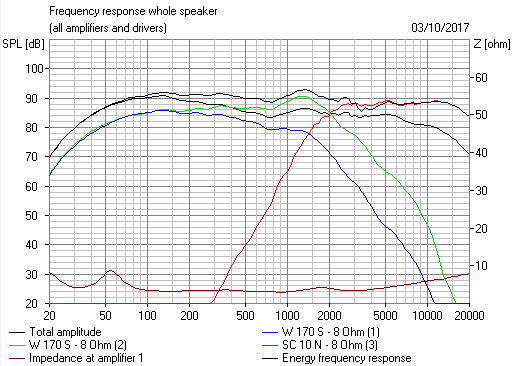
Not only is that a low crossover, but a very shallow one too. Compounded by a considerable BW3 overlap that pushes the tweeter even harder. 16uF and 0.25mH is VERY low for a 1" Tweeter, and I think the LCR notch could be deeper, because Troels uses 2.2R in his 6600 Fs LCR.
I think a more phase-aligned TMM design will help distortion:
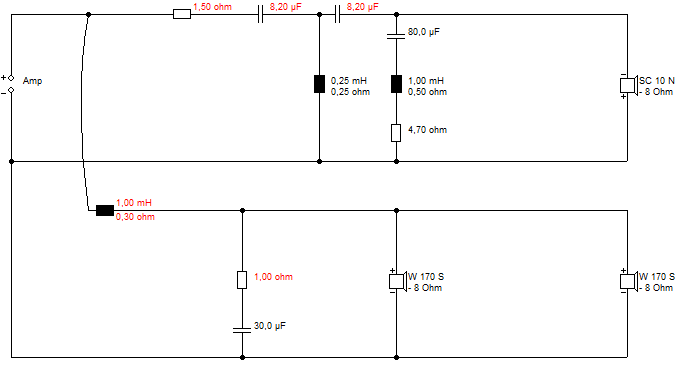
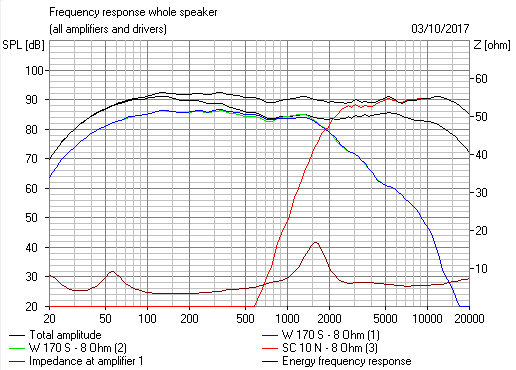
This just works better at every level IMO. You could even add a 4.5kHz tank-notch easily enough around 15R and 1.2uF across the bass coil.
Tweeter sound depends quite critically in keeping it away from overly low and shallow crossover. My little Monacor HT-22/8 cone tweeters are happy as Larry on 3rd order 3.5kHz. Give them second-order 2.5 kHz and they just don't sound as clean.
Now, ACOUSTICALLY the second order filter sounds better than the third. But it adds distortion, and after an hour or so it annoys me. This is the whole Little Girl with a Guitar syndrome. Great on Folk, rubbish on dense orchestral music.
The Michael Chua 1.7 kHz crossover is a very different animal. Steep LR4 4th order slopes and the characteristic crossover impedance peak of phase-aligned: Vifa PL18 Frequency Response
I was EXACTLY right in what needed doing. And it worked for another builder, Juancho. 😎
What we think is going on here is this in the 2.5 way:
Not only is that a low crossover, but a very shallow one too. Compounded by a considerable BW3 overlap that pushes the tweeter even harder. 16uF and 0.25mH is VERY low for a 1" Tweeter, and I think the LCR notch could be deeper, because Troels uses 2.2R in his 6600 Fs LCR.
I think a more phase-aligned TMM design will help distortion:
This just works better at every level IMO. You could even add a 4.5kHz tank-notch easily enough around 15R and 1.2uF across the bass coil.
Tweeter sound depends quite critically in keeping it away from overly low and shallow crossover. My little Monacor HT-22/8 cone tweeters are happy as Larry on 3rd order 3.5kHz. Give them second-order 2.5 kHz and they just don't sound as clean.
Now, ACOUSTICALLY the second order filter sounds better than the third. But it adds distortion, and after an hour or so it annoys me. This is the whole Little Girl with a Guitar syndrome. Great on Folk, rubbish on dense orchestral music.
The Michael Chua 1.7 kHz crossover is a very different animal. Steep LR4 4th order slopes and the characteristic crossover impedance peak of phase-aligned: Vifa PL18 Frequency Response
Attachments
Yes but the fact is that the tweeter can handle that low xover point without issue. Just look at the measurements, all orders of HD remain extremely low even down to 500Hz. Yeah the third order peaks up a little by that time but it's still 50dB down, which is as good as some drivers are across their entire operating range. Second order naturally rises but you aren't going to hear that in a month of Sundays.
Yes the Wilmslow design was a trainwreck but it was that right from the start. The Zaph design is hardly that and the only thing wrong with it, that you can see, is the low xover point.
We know the tweeter isn't going to complain about this unless pushed to very loud listening levels. And although the problem appears less pronounced at lower listening levels (they always do) the general issue is still present. This tweeter can cross over at 1700Hz 2nd order acoustic at lower levels without a problem. So why don't we actually look at what can cause listening fatigue.
High distortion certainly can but HD2 and HD3 aren't the orders that typically do. It's the higher orders that do that and the tweeter here needs to be pushed very hard to make that happen. It's not beyond the realm of possibility, but all the objective data points towards this not being the problem.
The tweeters could be faulty, it happens, but I'd be surprised at that given scanspeaks quality control.
Dispersion patterns can easily cause listening fatigue, especially if you have hyperacusis, mild or otherwise. The speakers and room are responsible for this together and if you have a combination that doesn't suit your ears then the speakers can be as good as you like they will never sound good.
This is why I asked if the original poster has examples of any speakers that don't have listening fatigue. The ZRT is not your typical two way. The low xover point largely does away with the wide-narrow-wide dispersion pattern that plagues a lot of similar designs. The low xover point should really help to reduce listening fatigue created by poor dispersion but the room is important here too.
Wide narrow wide designs typically melt my ears, as I do have hyperacusis. I tried everything to get rid of listening fatigue, nothing worked. Waveguides, directivity matches and controlled directivity fixed that.
Beyond distortion and directivity/room the number one thing that will cause listening fatigue is just the good old frequency response being unbalanced. Like I said, the low xover point of the tweeter makes the tweeter level very important here in achieving a pleasing tonal balance.
I would mention bafflestep compensation levels too but as this is a 2.5way design that should be completely corrected for. However what does jump out at me is the fact that merlin has already performed some basic measurements that do indeed show a distinct lack of energy in the frequency range that should not be there if bafflestep has been corrected for.
That might be the symptom but possibly not the cause.
The full BSC design will have a tendency to shelve up the bass frequencies, which merlin has confirmed to be the case. If the tweeter level was set too high then this would shelve up the area between around 1500Hz - 20kHz in this design (low xover point and 3rd order slope). With the bass shelved up and the tweeter shelved up this would create a depression/lack of energy in the region you'd expect bafflestep to have corrected for.
Turn the tweeter down, get rid of the high frequency upward shelf and then what you're left with is a flat frequency response plus some more bass.
We have confirmed that people have used the mid/bass here without these kind of problems. I've seen people use the same tweeter in similar situations without trouble and we have people saying that they've built the ZRT and they aren't fatiguing. 2.5 way version or not Zaph isn't deaf and if the 2.5 way was fatiguing Vs the 2 way he'd redesign the 2.5 way. Yes we've had people saying that they've built one Zaph design that seemed a little on the hot side, but this is why Zaph includes bafflestep and tweeter level options.
Yes the Wilmslow design was a trainwreck but it was that right from the start. The Zaph design is hardly that and the only thing wrong with it, that you can see, is the low xover point.
We know the tweeter isn't going to complain about this unless pushed to very loud listening levels. And although the problem appears less pronounced at lower listening levels (they always do) the general issue is still present. This tweeter can cross over at 1700Hz 2nd order acoustic at lower levels without a problem. So why don't we actually look at what can cause listening fatigue.
High distortion certainly can but HD2 and HD3 aren't the orders that typically do. It's the higher orders that do that and the tweeter here needs to be pushed very hard to make that happen. It's not beyond the realm of possibility, but all the objective data points towards this not being the problem.
The tweeters could be faulty, it happens, but I'd be surprised at that given scanspeaks quality control.
Dispersion patterns can easily cause listening fatigue, especially if you have hyperacusis, mild or otherwise. The speakers and room are responsible for this together and if you have a combination that doesn't suit your ears then the speakers can be as good as you like they will never sound good.
This is why I asked if the original poster has examples of any speakers that don't have listening fatigue. The ZRT is not your typical two way. The low xover point largely does away with the wide-narrow-wide dispersion pattern that plagues a lot of similar designs. The low xover point should really help to reduce listening fatigue created by poor dispersion but the room is important here too.
Wide narrow wide designs typically melt my ears, as I do have hyperacusis. I tried everything to get rid of listening fatigue, nothing worked. Waveguides, directivity matches and controlled directivity fixed that.
Beyond distortion and directivity/room the number one thing that will cause listening fatigue is just the good old frequency response being unbalanced. Like I said, the low xover point of the tweeter makes the tweeter level very important here in achieving a pleasing tonal balance.
I would mention bafflestep compensation levels too but as this is a 2.5way design that should be completely corrected for. However what does jump out at me is the fact that merlin has already performed some basic measurements that do indeed show a distinct lack of energy in the frequency range that should not be there if bafflestep has been corrected for.
That might be the symptom but possibly not the cause.
The full BSC design will have a tendency to shelve up the bass frequencies, which merlin has confirmed to be the case. If the tweeter level was set too high then this would shelve up the area between around 1500Hz - 20kHz in this design (low xover point and 3rd order slope). With the bass shelved up and the tweeter shelved up this would create a depression/lack of energy in the region you'd expect bafflestep to have corrected for.
Turn the tweeter down, get rid of the high frequency upward shelf and then what you're left with is a flat frequency response plus some more bass.
We have confirmed that people have used the mid/bass here without these kind of problems. I've seen people use the same tweeter in similar situations without trouble and we have people saying that they've built the ZRT and they aren't fatiguing. 2.5 way version or not Zaph isn't deaf and if the 2.5 way was fatiguing Vs the 2 way he'd redesign the 2.5 way. Yes we've had people saying that they've built one Zaph design that seemed a little on the hot side, but this is why Zaph includes bafflestep and tweeter level options.
Everybody seems to be in denial about how wretched this horribly overpriced Scanspeak sliced paper 18W-8531-G00 6" woofer actually is.

If my 5-y-o nephews admitted to slicing the cone with a knife and then gluing it back together before I got home, would I be pleased? Not really too thrilled, TBH.
Below is Michael Chua's preferred paper Vifa PL18W0 woofer. Much better response that I might work with. Lastly is a typical metal woofer. Well, forget about it, IMO. Unless you are seriously good at filters.
If my 5-y-o nephews admitted to slicing the cone with a knife and then gluing it back together before I got home, would I be pleased? Not really too thrilled, TBH.
Below is Michael Chua's preferred paper Vifa PL18W0 woofer. Much better response that I might work with. Lastly is a typical metal woofer. Well, forget about it, IMO. Unless you are seriously good at filters.
Attachments
- Status
- Not open for further replies.
- Home
- Loudspeakers
- Multi-Way
- Zaph / Madisound ZRT 2.5 Problem
